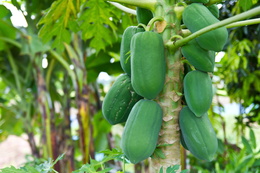This article provides relevant information related to pawpaw tree that will help you in proper identification of the tree. It will also help you to understand how to grow pawpaw tree at home. Read on...

The scientific name of pawpaw tree is
Asimina triloba. It is also commonly known by other names like Hoosier banana and poor man's banana. This tree belongs to Annonaceae family which is the same as that of custard apple, ylang-ylang, cherimoya, etc. Even though these small, clustered ornamental tree look like any other tropical tree but actually it is native to North America and is grown in large-scale in the eastern United States. In its natural habitat, these trees are more often found near river beds and has a tendency to grow under larger trees.
Pawpaw Tree Information
This tree is well-known for its narrow pyramidal structure and dense foliage. On an average, the size of a paw paw tree varies in between 15-20 feet. Some of them may grow up to a height of 25 feet. The diameter of its trunks is about 8 inches.
Its leaves are somewhat oblong in shape and dark green in color that grows to a length of 12 inches. These leaves tend to droop in the downward direction from its branches. At the onset of autumn, these green leaves turn yellow and fall off. Then fresh new leaves emerge all over again during spring after the blooms appear on the tree.
The flowers can be identified with its dark brown color and a soft, velvety texture. These flowers are suspended in upward down position from the tree. Pawpaw fruits are big and fat that weighs about one pound. It is an edible fruit with a sweet and creamy texture. This fruit grows in a bunch where each bunch has almost 8-9 fruits. Inside the fruit, there are two rows of big seeds that look very similar to lima beans.
Growing Pawpaw Tree
Pawpaw tree grows well in warm and humid weather condition but it is quite tolerant towards frost conditions as well. Idea soil condition required for paw paw tree is a rich, well-drained soil which is slightly acidic in nature. It can be grown both outdoors as well as indoors in containers. The location of the tree should be such that it receives full sun as sunlight is essential for the growth of its rich foliage.
Seeds should be sown during fall and winter for germination. After sowing the seeds, water the soil on a regular basis in order to ensure that the seeds do not become dry. Four months later, as the spring sets in, you have to transplant the seedlings at the actual location where you wish to grow the pawpaw tree. The tree cannot grow in dry soil. Therefore, it should be watered very frequently which can ensure its proper growth particularly during the growing season.
Mulching the soil is important as it prevents growth of weeds and help the soil to retain its moisture. Fertilizers should be added to the soil two times in a year. Potassium rich organic fertilizers are most suitable for pawpaw tree. When you provide the tree with proper growing condition, then it can grow quite rapidly. Within next 5-6 years, the plant will grow to a height of 6 feet and start bearing fruits. Ripe fruits are harvested from thr tree in the months of August to October.
Most people grow the pawpaw tree either for the purpose of landscaping or for its nutritious fruit. You will be surprised to know that its fruit is not just delicious but is an excellent source of carbohydrates, fat and protein. Besides, it has a high amount of other valuable nutrients like vitamin C, antioxidants, unsaturated fatty acids, etc. When you are growing the tree for its fruits, then you must plant more than one tree in your garden in order to facilitate proper cross-pollination.






 The scientific name of pawpaw tree is Asimina triloba. It is also commonly known by other names like Hoosier banana and poor man's banana. This tree belongs to Annonaceae family which is the same as that of custard apple, ylang-ylang, cherimoya, etc. Even though these small, clustered ornamental tree look like any other tropical tree but actually it is native to North America and is grown in large-scale in the eastern United States. In its natural habitat, these trees are more often found near river beds and has a tendency to grow under larger trees.
The scientific name of pawpaw tree is Asimina triloba. It is also commonly known by other names like Hoosier banana and poor man's banana. This tree belongs to Annonaceae family which is the same as that of custard apple, ylang-ylang, cherimoya, etc. Even though these small, clustered ornamental tree look like any other tropical tree but actually it is native to North America and is grown in large-scale in the eastern United States. In its natural habitat, these trees are more often found near river beds and has a tendency to grow under larger trees.